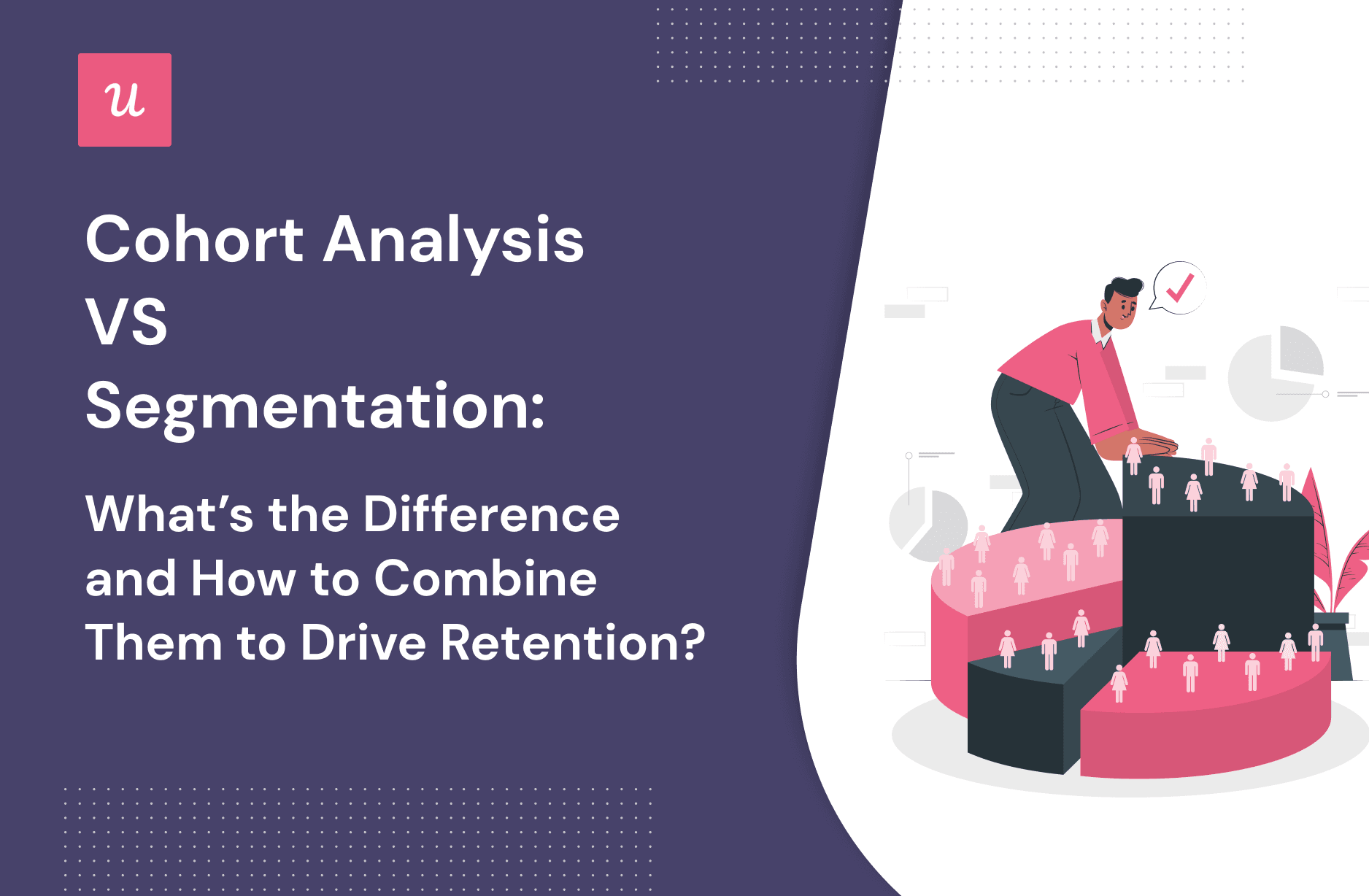
Cohort Analysis vs. Segmentation: What’s the Difference and How To Combine Them To Drive Retention?
Cohort analysis vs. segmentation — which method to apply when identifying product growth opportunities and retention strategies?
The answer is both. To analyze different aspects of a business or product, product managers use cohort analysis and customer segmentation. The methods are not interchangeable, but rather complementary.
Here, we’ll talk about the applications of each method and show you how to implement them.
Let’s dive right in!
Try Userpilot Now
See Why 1,000+ Teams Choose Userpilot

Summary of cohort analysis vs. segmentation
- The cohort analysis is a time-bound method of segmenting users. When conducting cohort analysis, you must work with customer data from a specific time period.
- Cohorts, in turn, are user groups that share common characteristics over a certain period of time or event.
- The cohort analysis allows you to pinpoint your business’s bad and good months based on revenue generated, new subscriptions, and churned customers so you can dig deeper and identify the causes.
- Customer segmentation is the process of dividing your customer base into different groups based on shared characteristics or behavior. Unlike cohort-based segmentation, user segmentation is not linked to a specific time period.
- With user segmentation, you can understand which customers are the largest contributors to revenue and have the highest growth potential, which cannot be done with cohort analysis.
- Cohort and segment analysis together will help you identify friction points in a given period and user groups at a high risk of aversion.
- Use cohort analysis to identify features that drive the maximum engagement and find obstacles across the customer journey.
- Choose to segment users when you want to deliver a better customer experience, increase Customer Lifetime Value, and identify friction points.
- To retain customers using both methods, you need to track feature usage and identify the most and least sticky features.
- After tracking feature usage, group customers with common behavioral patterns in a given period of time to analyze product adoption over time.
- Lastly, analyze behavioral cohorts and segments then compare them with one another to identify issues that led to disengaged customers, drop-offs, or stalled users. Then you can go for different customer retention strategies to win users back.
Are You Using the Right Analytics Method?
Cohort analysis and segmentation are powerful, but knowing when to use which is the key to growth. Are you using cohort analysis vs segmentation to improve customer engagement correctly? Take this quick check.
You want to see if a product update in March caused a drop in retention compared to February. Which method do you use?
You want to target a specific group of “Power Users” with an upsell offer right now. Which method is best?
Can you combine both methods to find “At-Risk” cohorts?
Master Both Strategies with Userpilot
Don’t choose between history and the present. Userpilot lets you run deep cohort analysis and create real-time behavioral segments to trigger the perfect in-app experience.
What is cohort analysis?
Cohort analysis is a type of behavioral analytics that helps you see what a sub-section of your users (a “cohort”) is doing within your tool. Unlike the customer segment, the user cohort is a group of users that is observed over a specific time period.
This means that every time you conduct cohort analysis, you have to work with data from a particular time period. Most SaaS companies apply it on a month-to-month basis.
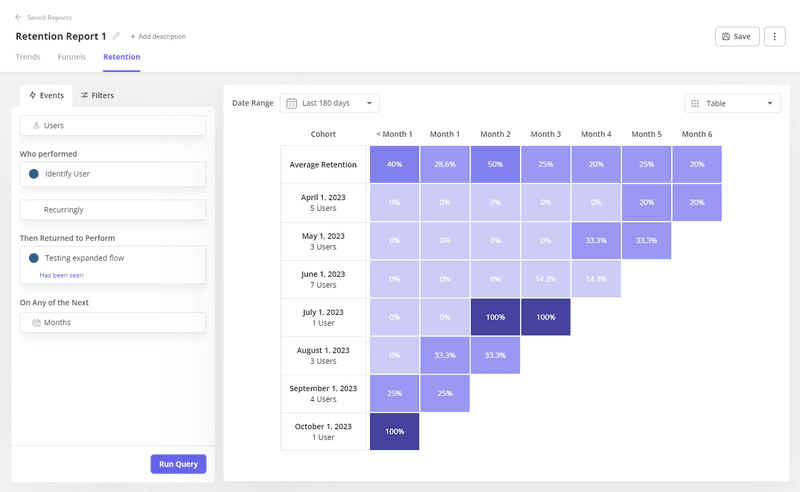
Why is cohort analysis important in SaaS?
Cohort analysis will allow you to spot months and seasonal patterns when your product performs poorly or well in terms of revenue generated, new subscriptions, churned customers, etc.
If you compare the churn rate among different cohorts of users, you can see how the churn rate changes based on when they sign up for your tool. This can provide valuable insight into the effectiveness of your product and marketing strategies.
Cohort analysis will also enable you to gather enough user data to identify friction points and other actionable insights.
What is customer segmentation?
Customer segmentation is the process of dividing your customer base into different groups based on shared characteristics or behavior (location, MRR, activity, NPS score). The primary difference between cohorts is that user behavior segments are not linked to a specific period (unless you really want to).
For instance, use needs-based customer segments to compare how fast users from the cheapest plan adopt the product against enterprise ones. Or any other cases, you want to understand the difference in customers’ behavior towards the same milestone or goal.
Why is customer segmentation important in SaaS?
With customer segmentation, you can understand which group of users are the largest contributors to revenue and have the highest growth potential, which cannot be done with cohort analysis.
This is because you can set any criteria for your segments and analyze their behavior on a deep level, without being limited by time ranges.
For example, you can determine which group of customers reaches the activation point the fastest. You can then dig in and see if this segment generates the most revenue or churns within the first months of product usage.
In a nutshell, customer segmentation provides you with a better understanding of your customers so that you can personalize product messages and delight your customers with tailored strategies like a personalized onboarding experience.
On the other hand, segmentation can help you spot user segments that are not profitable as they require lots of resources to attract and retain them.
Customer cohorts vs. customer segments: What are the key differences?
Here let’s get straight to the point and compare the main differences between customer segments and cohorts.
Cohorts are time or event-based
Cohorts are user groups with shared characteristics over a certain period of time or event—for example, new customers who activated or got stalled in the last 30 days. Here you can see that the cohort is both event-based and time-bound. But time is a crucial factor.
Segments are groups that share common interests and behaviors
In turn, segments are groups that share the same characteristics and behavior but are not time-bound. These characteristics could be anything from customer size, industry, MRR, location, NPS score, customer effort score, etc.
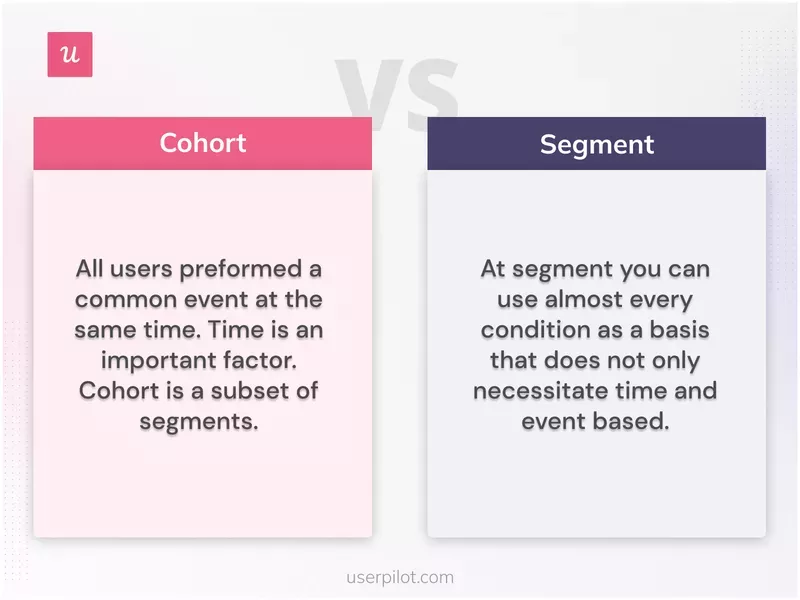
Cohort analysis use cases
Let’s get more granular and learn through the most common use cases for cohort analysis for SaaS companies.
Understand customer needs
Cohort analysis helps you dig down into the details and understand customers on a deeper level. In other words, cohort analytics enables you to understand what users like/dislike most about your product as you can gain insights into how a specific customer segment adopts your product features over time.
Identify features that drive the maximum engagement
You can understand the stickiest features that drive the most engagement or revenue among all customers and specific segments.
Use this data to recognize the most profitable features and make informed decisions about what product updates to prioritize in order to increase the conversion rate into paying customers, increase customer lifecycle or grow LTV.
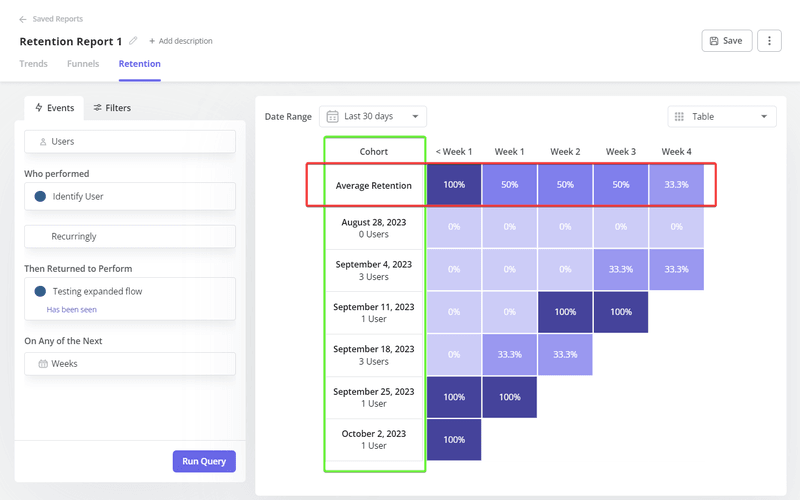
Figure out how customers react to a new feature
Use cohort analysis to track down the adoption of new features. To do so, you can create cohorts over a specific period, say one month after the product update, to see how customers react to a new feature.
This will help you answer what percentage of users actually find product tweaks useful.
Customer segmentation use cases
Here we will go through the three most actionable use cases of user segmentation.
Let’s start!
Identify users before they churn
Using a tool you can segment users based on their behavior within the product and beyond, you can identify users who are slipping away. Reach out to them before they become completely inactive. By eliminating friction points in the customer journey, you will reduce churn.
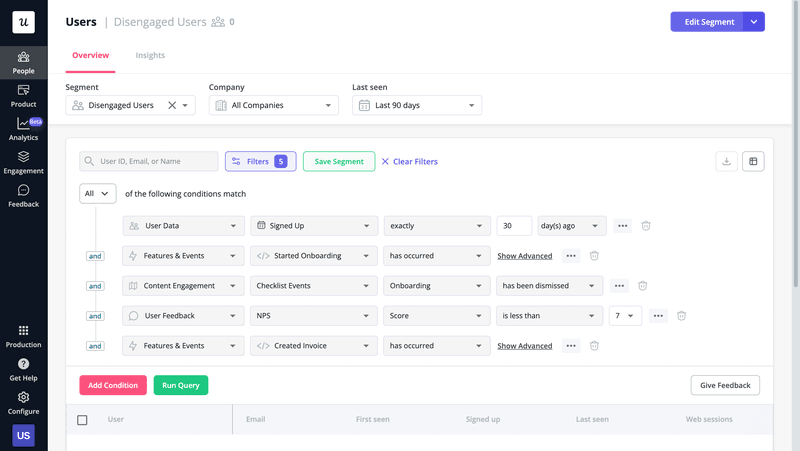
Deliver a better customer experience and increase customer lifetime value
Segmenting customers will help you reach out to specific users that need help and guide them. For instance, implement interactive walkthroughs as a part of onboarding to get new customers to the “Aha” moment in the shortest way possible. The key is to deliver the right in-app experience at the right time so it doesn’t frustrate users.
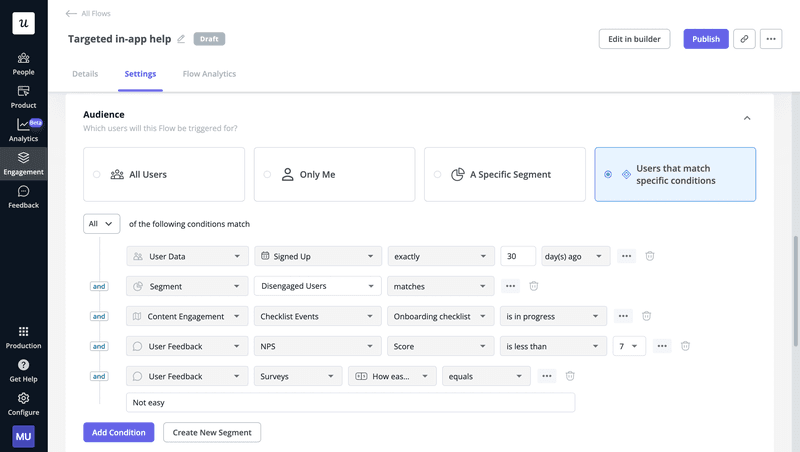
This will ultimately boost CLV (LTV) following the rule of thumb “the happier customers—the more revenue”.
Drive-up customer retention
Ultimately, customer segmentation can be used to boost your customer retention rate as you will recognize problems or bugs that impair user experience and impact customers’ decisions to churn.
You can proactively reach out to customers and retain them once you collect insights into their product usage and the problems they face.
How to combine cohort analysis with segmentation to increase retention
Now let’s have some fun putting knowledge into action!
Here you will learn how to carry out cohort analysis relying solely on user behavior (user segments).
Track feature usage and find out the stickiest features
Let’s begin by understanding what feature tracking means. To learn this, we will use a real-world example.
Example: Product managers want to understand how many customers and how often they use a particular feature to estimate its adoption rate and make sure there’s no friction in the customer journey.
By analyzing feature usage data, PMs can identify the most and least liked features in the product.
You can track feature usage with a product analytics tool like Userpilot. The tool enables you to tag specific UI patterns of your features that will be triggered after customers click on them (see screenshot below).
When you analyze the data collected, you will learn which features are the most sticky.
That will be the first step in a cohort analysis with segmentation.
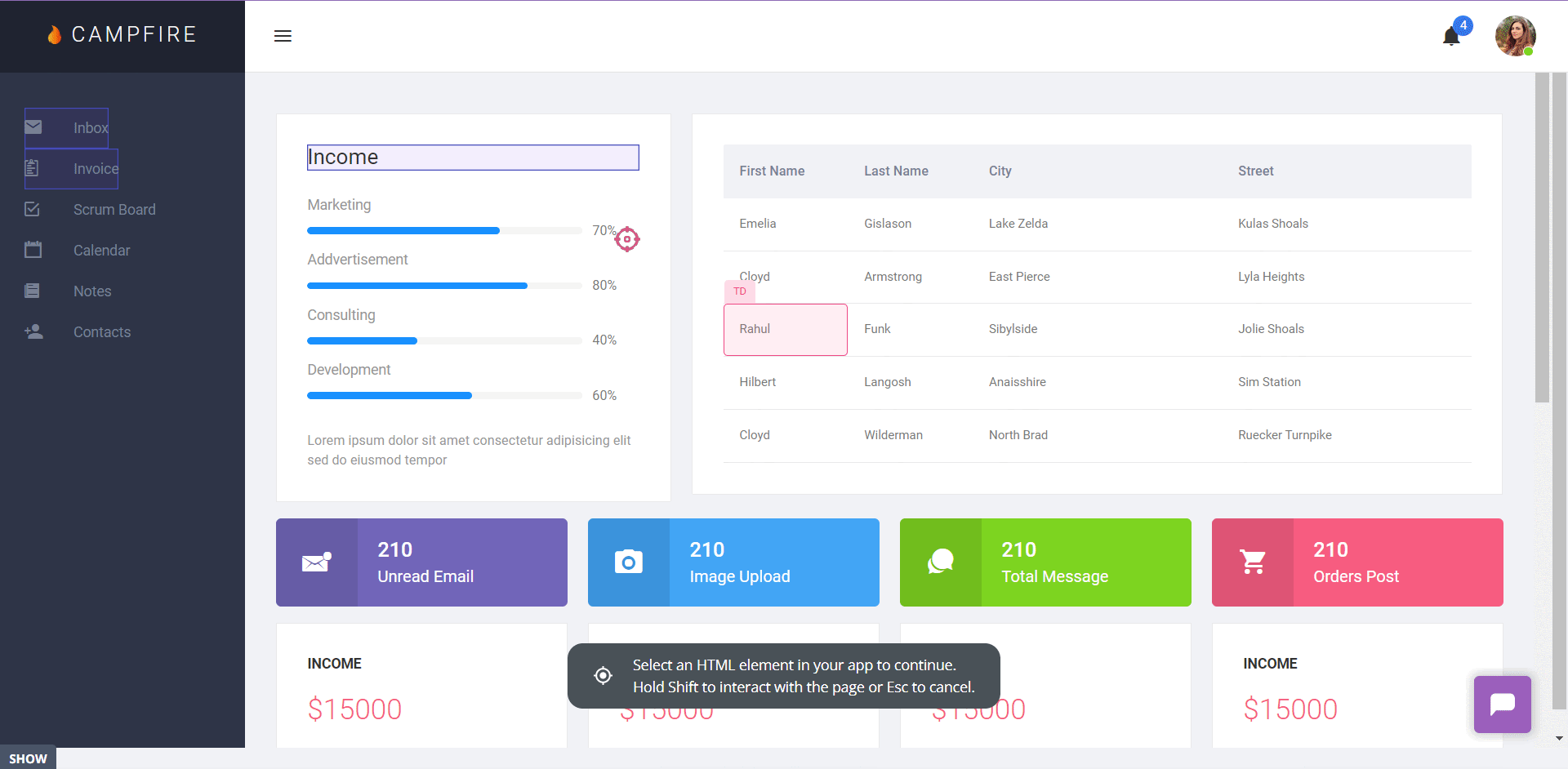
Want to track feature adoption and build in-product experiences to increase engagement? Get a Userpilot demo and get started!
Detect common patterns and define cohorts in a specific time period
After tracking feature usage, you need to group customers with common behavioral patterns in a given period of time.
Therefore, you can see what days or months users churn the most. In the example below, you can see that the fifth month became the most painful month due to drastic customer aversion. Therefore, it is reasonable to conclude that the changes made in prior months proved to be a disaster.
Meanwhile, you should also pay attention to the “light purple” months and figure out what doubled down churn.
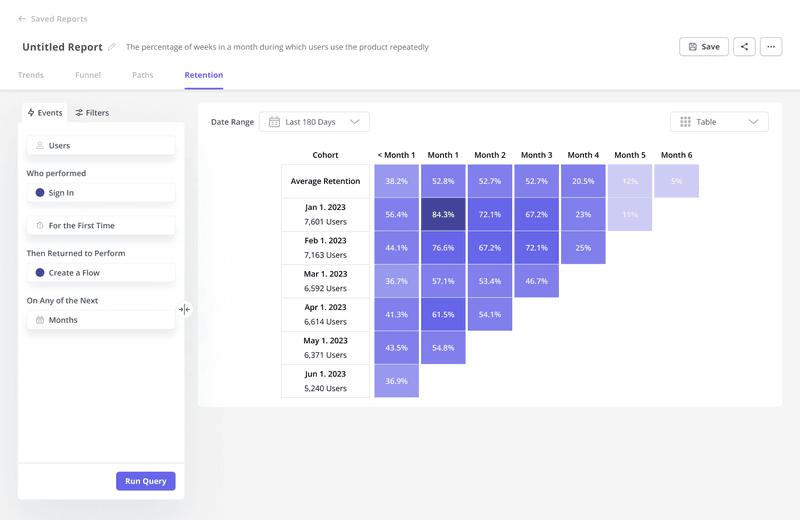
Analyze behavioral cohorts and compare them with one another
In this step, you need to dig deeper and compare cohorts to each other to analyze trends in their behavior. For this, we will be using the A/B testing feature by Userpilot.
But let’s look at an example first. Imagine that you identified the cohort segment that signed up a month ago (January) and has not engaged with the core features. Now your primary goal is to help those users discover and use those features if they haven’t churned yet.
So we’ll build a segment to identify them and launch an in-app feature discovery flow.
You can also run an A/B-test to see which type of in-app experience can drive better feature adoption.
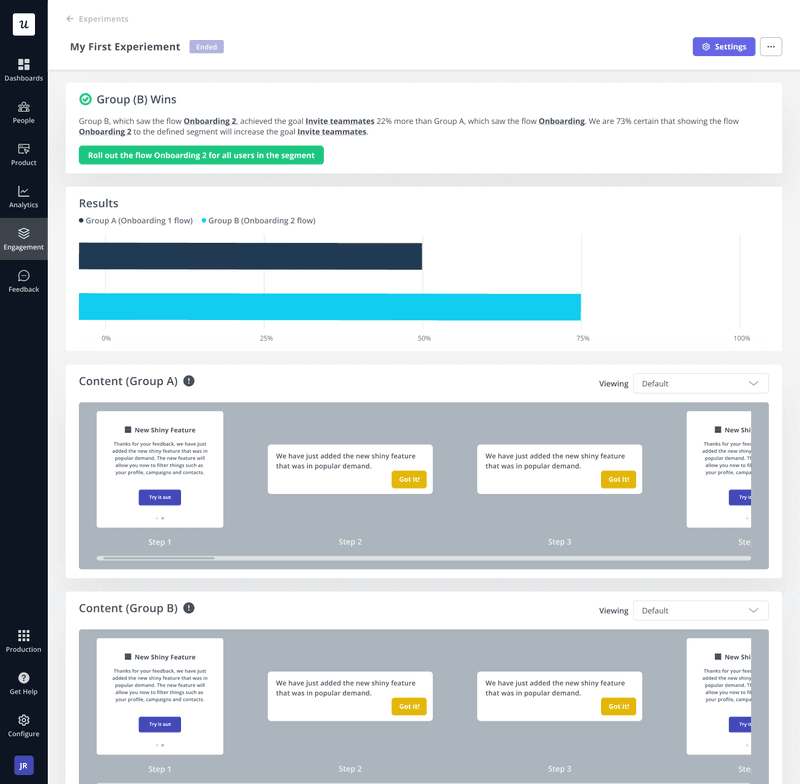
Group cohorts into segments that share common characteristics
A different approach to identifying problematic cohorts is to group them into segments that behave similarly. Divide a cohort into smaller, related groups based on different data points.
Those can vary from the NPS score to web session duration to completed milestones, etc.
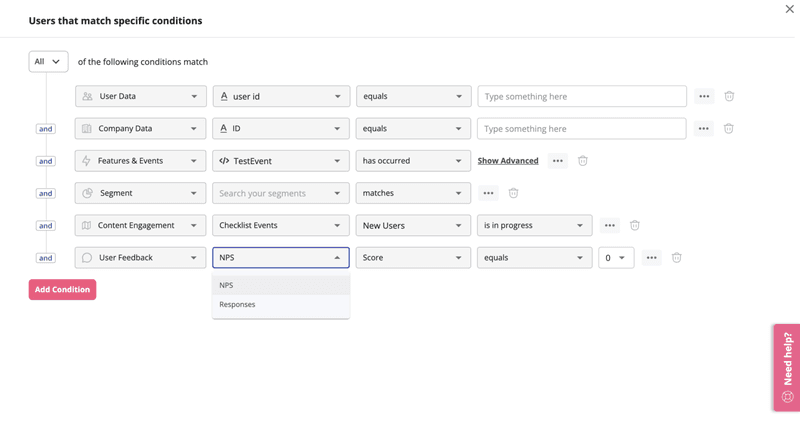
Once it’s done, you need to find a common characteristic of a successful segment and create a retention strategy for others based on the findings.
Take action to improve customer experience and retain customers
Lastly, put together all the data gathered and identify issues that led to disengaged customers, drop-offs, or stalled users.
Then you can go for different customer retention strategies to win users back at a high risk of churning:
- Create personalized onboarding flows for different personas.
- Build interactive walkthroughs to engage new customers and get them to the value faster.
- Implement modals or tooltips to facilitate feature discovery.
- Respond to in-app behavior: when a user starts a task, allocate them to that customer journey and offer support accordingly.
- Forge relationships with customers: run in-app micro surveys and NPS surveys to show users you care about their experience and want to build the best tool in the world based on customer needs.
- Proactive engagement: Engaging proactively means identifying the issue and the user segment that encounters it, and actively contacting them on various channels to prevent cancellations.
Conclusion
Both cohort analysis and user segmentation are important to collect data about your customers and understand them better. Each method gives you a different understanding of user behavior and you can create strategies based on the findings.
Want to segment your customers and build personalized product experiences for them code-free? Book a demo call with our team and get started!






